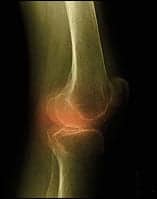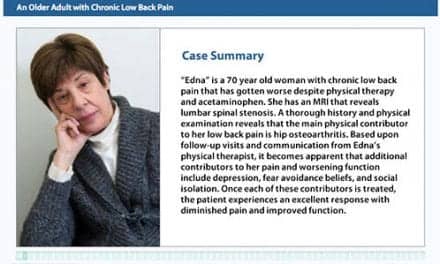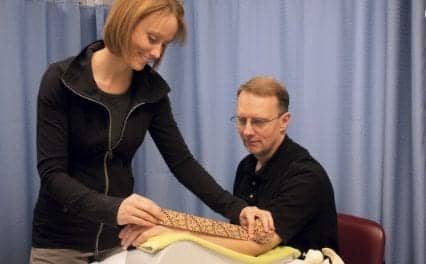 |
They are followed by a wake of change.
They powered the engines of the civil rights movement and raised a voice for peace strong enough to dismantle a war in Indochina.
From a popular song they appropriated the mantra for a generation:
“Hope I die before I get old.”
They have not died, for the most part, but Baby Boomers are getting older. Many are about to meet osteoarthritis head-on; and given their history as agents of change, Boomers affected by the disease likely will expect to alter the rules of engagement.
“Retire to a rocker? No more,” says Kyle F. Baldwin, DPT, CSCS, adjunct professor of physical therapy at the University of Southern California.
“This group has expectations from their care, and therapists need to be very clear about how they set up their rehab goals,” Baldwin says. “Boomers expect rehab professionals to help them not only maintain their overall independence but also improve their daily function.”
As functional independence grows more deeply connected to quality-of-life issues, pain treatment emerges as a focal point in treating osteoarthritic patients. According to Baldwin, science provides several options to Boomers that trump what was available to their parents.
He identifies five categories from which new treatments have risen: injectibles, oral medicines, oral supplements, physical therapy, and minimally invasive surgery.
“Injectibles such as [hylan] injected directly into the joint once a week for three consecutive weeks may help re-establish the proper lubrication in a joint,” Baldwin explains. Anti-inflammatory medicines also can benefit patients but are costly and over time may produce stomach upset, he adds.
Oral supplements, glucosamine and chondroitin, popularized by appearances in the media have become buzzwords among the lay. Their treatment efficacy for osteoarthritis, however, is a subject of dispute in scholarly research.
The two substances were roundly dismissed by Nortin Hadler in an April 17, 2007, ABC News report. Hadler, attending rheumatologist at the University of North Carolina Hospitals, said bluntly: “Ingesting chondroitin is a waste of money.”
In his own experience, Baldwin says some of his patients have reported benefits from using the supplements when taken over long periods of time.
As medications for treating osteoarthritis have progressed between generations, therapist training has improved as well. Baldwin points out that today’s therapist is more highly trained in movement sciences than their predecessors.
“Today’s PT helps patients maintain their level of function longer and helps keep them engaged in life’s activities,” Baldwin says. “They can use a whole host of modalities as well as hands-on techniques such as soft-tissue mobilization and stretching.”
Among some Boomers, conservative treatments for osteoarthritic symptoms will fall short. Increasingly, those patients may turn to minimally invasive orthopedic surgery as a pathway to a successful outcome.
“Today’s surgical patients spend a fraction of the time in the hospital and have speedier recoveries than the generation that preceded them,” Baldwin says. “The responses patients will have to any of the treatments—medication, therapy, or surgery—will vary and be dependent on how advanced a patient’s arthritis might be,” he adds.
At the far end of the continuum of osteoarthritis treatment is joint-replacement surgery, a once-extravagant procedure that has been downsized through advances in component materials, surgical technique, and postoperative therapies.
The evolution in joint replacement has been accompanied by a change in the profile for the joint-replacement candidate, according to Cynthia Bauer, PT, DPT, OCS, director of Musculoskeletal Outpatient Services at Good Shepherd Rehabilitation Network, Allentown, Pa.
“Years ago, we would not do total joint replacement on people who were in a certain overweight category,” Bauer says. “The integrity of the components wasn’t as strong, the adherence to the surfaces wasn’t expected to last as long, and the techniques to put it in weren’t there. Joints just were not put in.”
That is changing, Bauer says, and explains that improving interventions are being conducted in tandem with prosthetic devices that tolerate more pressure, fit better, and last longer than ever before. The advance in technique and materials has redrawn the osteoarthritic candidate for joint replacement as one who is increasingly heavier and increasingly younger.
In some cases, Bauer says, joint replacements now can last up to 20 years, which may lead some patients to embrace the procedure earlier.
Today, a patient who has chosen a surgical intervention will find the postoperative landscape characterized by rehabilitation that begins sooner and moves more swiftly to weight bearing so that patients can more quickly return to their routines. In the most common surgical intervention Bauer sees—knee replacement—patients generally are put in a continuous passive motion or CPM device soon after surgery, allowing the knee to be moved right away. “Therapy happens early. People get out of bed and are walking with an assistive device the day after knee replacement,” Bauer says, noting that today’s patients can complete rehabilitation in 2 to 3 months.
“Early movement is very important not to develop contractures, because that’s going to limit the way the patient functions if the joint heals that way. These people have a lifestyle they want to get back to,” Bauer says, “and at age 60 they’re still working, they’re skiing, dancing, and they’re going places. Their expectation of rehab is to get them back into an active lifestyle.”
PROVEN PROTOCOLS FOR PAIN MANAGEMENT
Most osteoarthritis sufferers will never need joint replacement; and for those who are able to ride out the daily discomfort of the disease without surgery, there are proven protocols for pain management.
Traditional methods that use rest, ice, elevation, and activity modification are still called on to treat flare-ups, according to Bauer, while persistent conditions can be addressed by transcutaneous electrical nerve stimulation. Heat, also, Bauer says, can be useful in opening circulation to alleviate swelling.
Controlling inflammation is rarely apart from controlling pain, Baldwin notes, adding that cryotherapy and therapeutic ultrasound have proven to be effective components of pain-management strategies. He says anti-inflammatory medications also can relieve pain among patients with mild to moderate osteoarthritis.
Despite having a cache of modalities to treat osteoarthritis pain, Baldwin says none of them alters the disease itself.
“Osteoarthritis is not a condition that physical therapists or anyone else ‘fixes.’ It’s always a management strategy,” he says.
Bauer says she believes that early diagnosis creates a valuable opportunity for patients to modify their lifestyles and learn techniques to prevent further breakdown.
“You want to help protect joints and strengthen muscles around joints to prevent deformities or future problems, so early diagnosis is important,” she says. “By understanding the strength or weakness that exists around joints, rehabilitation can focus on areas where strengthening is needed.”
Baldwin and Bauer agree that the greatest potential for derailing the onset of osteoarthritis may lie squarely within the boundaries of weight control, particularly among Boomers, who are becoming obese much earlier in life than their parents and are living with the effects of obesity longer.
By 2030, Centers for Disease Control and Prevention projects that 67 million Americans will develop some form of arthritis. Bauer connects the dots: “People are walking around with extra weight on their joints, and it feeds into a whole population of osteoarthritis. Obesity is certainly not going to help their joints,” she says.
“And we are worried about being able to handle these obese adults. The bariatrics equipment you need is becoming very significant, and the number of staff you need to service them is quite alarming.”
As Boomers progress along the osteoarthritis timeline, they may choose to independently explore treatment and lifestyle options for living with the disease. Baldwin and Bauer acknowledge that, with the help of the Internet, Boomers tend to be better-informed about medical issues than their parents, and generally prefer to participate in decisions that affect their own health care. Baldwin suggests beyond the confines of physical medicine Boomers may also discover an untapped ally for managing the disease simply by looking inward.
“A patient’s mind-set can determine how osteoarthritis affects them,” Baldwin says, pointing to the transformational dividends he has seen paid back to patients who have adopted a proactive stance. “If they play the role of osteoarthritis manager instead of osteoarthritis victim, they tend to be more independent and report lower levels of pain.”
Frank Long is associate editor of Rehab Management. For more information, contact





